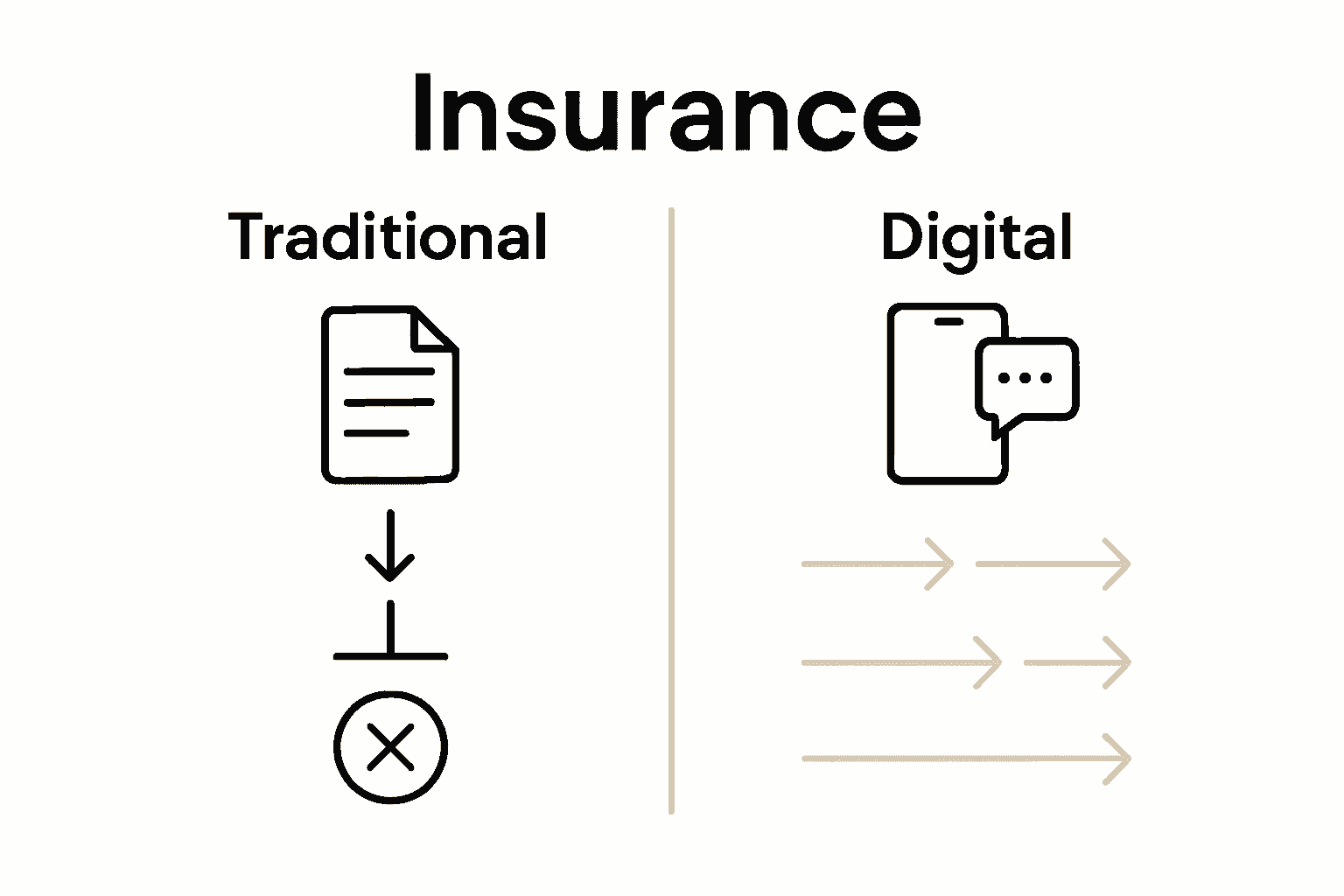02.11.25
Insurance Customer Experience: Complete Guide for 2025

Did you know that one out of five insurance customers avoids filing a claim because of digital frustration? Insurance is no longer just about paperwork and payouts. People expect quick service, personal attention, and seamless interaction every step of the way. As technology reshapes the industry, insurers face new demands to create genuine connections, reduce friction, and build long-term trust in an ever-changing market.
Table of Contents
- Defining Insurance Customer Experience Today
- Major Drivers of Customer Experience Value
- Digital Touchpoints and Technology Integration
- Measuring and Improving CX Performance
- Risks, Compliance, and Common Pitfalls
Key Takeaways
| Point | Details |
|---|---|
| Holistic Customer Experience | Today’s insurance customer experience encompasses every touchpoint and interaction, focusing on building relationships rather than solely transactional engagements. |
| Digital Transformation as a Driver | Insurers must leverage digital tools and advanced analytics to personalize interactions and streamline processes, meeting high customer expectations for seamless experiences. |
| Proactive Risk Management | Emphasizing proactive service and risk prevention strategies is crucial in ensuring customer trust and loyalty, especially in a rapidly evolving digital landscape. |
| Measurement and Continuous Improvement | Effective measurement of customer experience should be data-driven and proactive, incorporating tools like NPS and CES for ongoing enhancement and organizational alignment. |
Defining Insurance Customer Experience Today
Customer experience in insurance is no longer just about processing claims or selling policies. It’s a holistic journey that encompasses every interaction between an insurance provider and its customers.
According to the GovcX.org, a comprehensive framework for understanding customer experience involves four critical dimensions: Direction, Design, Development, and Delivery. While this framework originated in government services, it translates perfectly into the insurance landscape.
In the insurance context, customer experience represents the entire spectrum of interactions, emotions, and perceptions a customer has throughout their engagement with an insurance company. Digital.gov emphasizes that customer experience is fundamentally about the public’s perceptions and overall satisfaction with interactions, products, and services.
Key components of modern insurance customer experience include:
- Digital accessibility across multiple platforms and devices
- Personalized communication tailored to individual customer needs
- Transparent and quick claims processing
- Proactive risk management and prevention strategies
- Seamless omnichannel support
The evolution of insurance customer experience represents a shift from transactional interactions to relationship-building experiences that prioritize customer needs, trust, and long-term engagement. Insurers who understand and implement this approach will be best positioned to succeed in the competitive 2025 landscape.
Major Drivers of Customer Experience Value
The landscape of insurance customer experience is rapidly evolving, driven by technological advancements and changing customer expectations. At the core of this transformation are several critical drivers that are reshaping how insurers approach customer interactions and value delivery.
The CLM reveals a striking insight: 20% of consumers avoid filing insurance claims due to frustration with digital processes. This statistic underscores the paramount importance of creating smooth, intuitive digital experiences that reduce customer friction and encourage engagement.
Digital transformation has become the primary engine of customer experience value. As noted by BAI, customers now measure service quality against world-class online retailers, setting an incredibly high bar for digital interaction quality. This means insurers must deliver experiences that are not just functional, but exceptional.
Key drivers of customer experience value include:
- Personalization through advanced data analytics
- Seamless omnichannel interactions
- Real-time communication and support
- Predictive and proactive service models
- Transparent and simplified processes
Moreover, customer experience in the driver’s seat of insurance transformation highlights how modern insurers are reimagining their approach. The goal is no longer just transactional efficiency, but creating meaningful, empathetic interactions that build long-term customer trust and loyalty.
Technology, when deployed thoughtfully, becomes the primary lever for enhancing customer experience. Machine learning, AI-driven personalization, and intuitive digital interfaces are transforming how insurers understand, anticipate, and meet customer needs. The most successful insurance providers will be those who view technology not as a cost center, but as a strategic tool for deepening customer relationships.

Digital Touchpoints and Technology Integration
The modern insurance landscape is defined by sophisticated digital touchpoints that seamlessly connect customers with their insurance providers. Technology integration has transformed the traditional insurance interaction from a transactional experience to a dynamic, personalized journey.
Digital.gov highlights the critical importance of digital customer experience, demonstrating how organizations are meticulously evaluating and improving digital interfaces. Their strategy of comprehensively reviewing public-facing digital platforms serves as a benchmark for insurers seeking to enhance their technological ecosystem.
Digital touchpoints now encompass a wide range of technological interactions. Insurtech World reveals compelling evidence of how advanced digital solutions like 360Siteview can revolutionize customer experiences by creating unified digital records for claims, dramatically improving communication and reducing operational complexity.
Key digital touchpoints in modern insurance include:
Here’s a comparison of the main digital touchpoints and their customer experience benefits:
| Digital Touchpoint | Primary Benefit | Example Feature |
|---|---|---|
| Mobile Applications | Convenient access on-the-go |
Policy management dashboard |
| AI-powered Chatbots | Instant support 24/7 |
Claims status updates |
| Automated Claims Processing | Faster settlements less friction |
Self-service claim filing |
| Personalized Online Dashboards | Tailored information engagement |
Coverage recommendations |
| Real-time Risk Assessment Tools | Proactive service greater trust |
Risk alerts & notifications |
| Omnichannel Communication Systems | Consistency seamless experience |
Integrated support channels |
- Mobile applications with comprehensive policy management
- AI-powered chatbots for instant customer support
- Automated claims processing platforms
- Personalized online dashboards
- Real-time risk assessment tools
- Seamless omnichannel communication systems
Enhancing Customer Experience with Digital Transformation emphasizes that successful technology integration is not just about implementing new tools, but creating a cohesive, intuitive ecosystem that anticipates and meets customer needs.
Technology integration demands a holistic approach. Insurers must view digital touchpoints as more than mere communication channels—they are strategic assets that drive customer engagement, loyalty, and operational efficiency.
 The future of insurance lies in creating intelligent, responsive digital experiences that feel personal, immediate, and genuinely helpful.
The future of insurance lies in creating intelligent, responsive digital experiences that feel personal, immediate, and genuinely helpful.
Measuring and Improving CX Performance
Measuring customer experience (CX) performance is no longer a passive exercise but a dynamic, strategic imperative for insurance providers. Modern insurers must adopt comprehensive, data-driven approaches to understanding and enhancing customer interactions across every touchpoint.
Digital.gov provides an illuminating blueprint through their Service Design program, which demonstrates how organizations can systematically capture both qualitative and quantitative data to assess and improve customer-centricity. This approach underscores the importance of holistic evaluation beyond traditional metrics.
BAI highlights that leading organizations are investing heavily in technology platforms designed to create frictionless experiences and measure digital customer interactions with unprecedented precision. This investment reflects a fundamental shift from reactive to proactive customer experience management.
Key performance measurement strategies include:
- Net Promoter Score (NPS) tracking
- Customer Effort Score (CES) assessments
- Real-time feedback mechanisms
- Comprehensive journey mapping
- Predictive churn analysis
- Sentiment analysis across digital channels
Through 2025 Guide to Insurance Analytics, insurers can understand how advanced analytics transform raw interaction data into actionable insights. The goal is not just measurement, but continuous improvement.
Successful CX performance measurement requires a cultural commitment to customer-centricity. It demands breaking down organizational silos, integrating cross-functional insights, and creating a feedback loop that enables rapid, meaningful improvements. The most successful insurers will be those who view customer experience not as a department, but as a comprehensive organizational strategy.
Risks, Compliance, and Common Pitfalls
The insurance industry stands at a critical intersection of technological innovation and regulatory complexity. Navigating this landscape requires a sophisticated approach to managing risks, ensuring compliance, and mitigating potential pitfalls that could compromise customer trust and organizational stability.
The Payments Association reveals a striking trend: concerns about financial crime and cybersecurity have escalated from 21% in 2023 to 30% in 2025, now surpassing compliance as the industry’s most significant challenge. This shift underscores the growing importance of robust risk management strategies in the digital insurance ecosystem.
Preprints highlights the delicate balance required in digital transformation, particularly in regulatory environments like the EU, where insurers must simultaneously drive innovation, protect consumer interests, and maintain market stability. This complex landscape demands a nuanced approach to risk management.
Common risks and compliance challenges include:
- Cybersecurity vulnerabilities
- Data privacy regulatory violations
- Inadequate customer data protection
- Inconsistent regulatory compliance
- Legacy system integration risks
- Algorithmic bias in AI-driven decisions
Understanding Insurance Compliance Automation provides critical insights into how modern insurers can proactively address these challenges through advanced technological solutions.
Successful risk management is not about elimination, but strategic mitigation. It requires a holistic approach that integrates technological innovation, rigorous compliance frameworks, and a culture of continuous learning and adaptation. The most resilient insurance organizations will be those that view compliance not as a burden, but as a strategic opportunity to differentiate and build customer trust.
Elevate Your Insurance Customer Experience with Proven Digital Solutions
The 2025 guide on insurance customer experience highlights major challenges insurers face such as digital friction, slow claims processing, and the urgent need for seamless omnichannel interactions. These pain points often cause customer frustration and lost loyalty. To meet today’s high customer expectations, insurers must deliver personalized, transparent, and fast experiences that build lasting trust.
That is where Insurance Business Applications can help. Our cloud-native core insurance platform, IBSuite, is designed to streamline your entire insurance value chain—from underwriting to claims and billing—while enabling rapid product innovation and real-time customer engagement. With a secure, API-first architecture, IBSuite supports digital transformation by simplifying processes and reducing IT complexity. This means you can offer your customers intuitive mobile apps, AI-powered support, and proactive risk management tools all integrated into one cohesive system.
Are you ready to transform your customer experience and stay ahead in a competitive market? Discover how IBSuite helps you embrace new distribution models and enhance every digital touchpoint. Take the next step now by scheduling a demo with IBA. Empower your business to deliver the customer experience your policyholders expect and deserve.
Frequently Asked Questions
What is insurance customer experience?
Insurance customer experience refers to the entire journey and interactions a customer has with an insurance provider, encompassing emotions, perceptions, and satisfaction throughout these engagements.
How can technology enhance the insurance customer experience?
Technology enhances insurance customer experience through digital touchpoints such as mobile apps, AI chatbots, and automated claims processing, creating seamless, personalized, and efficient interactions.
What are key components of modern insurance customer experience?
Key components include digital accessibility, personalized communication, quick claims processing, proactive risk management, and omnichannel support.
How is customer experience measured in the insurance industry?
Customer experience in insurance is measured using methods like the Net Promoter Score (NPS), Customer Effort Score (CES), real-time feedback mechanisms, and sentiment analysis, enabling continuous improvement of services.
Recommended
- Customer experience in the driver’s seat of insurance transformation – Digital Insurance Platform | IBSuite Insurance Software | Modern Insurance System
- Complete Guide to Digital Insurance Trends 2025 – Digital Insurance Platform | IBSuite Insurance Software | Modern Insurance System
- Enhancing Customer Experience with Digital Transformation – Digital Insurance Platform | IBSuite Insurance Software | Modern Insurance System
- 7 Policy Administration Best Practices for Insurers – Digital Insurance Platform | IBSuite Insurance Software | Modern Insurance System